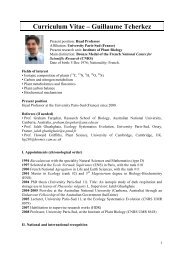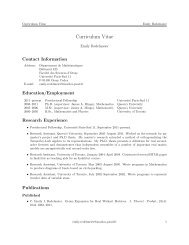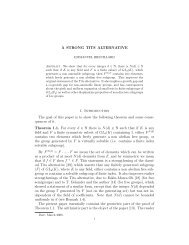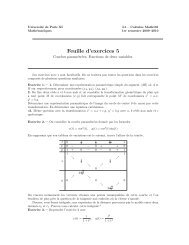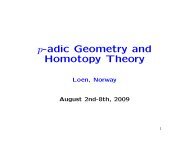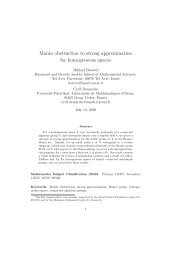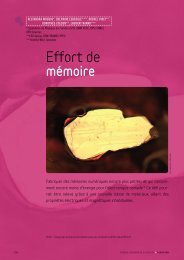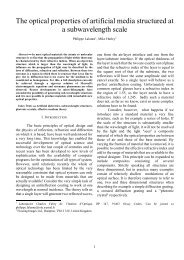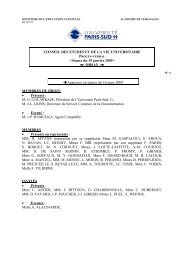Birational invariants, purity and the Gersten conjecture Lectures at ...
Birational invariants, purity and the Gersten conjecture Lectures at ...
Birational invariants, purity and the Gersten conjecture Lectures at ...
You also want an ePaper? Increase the reach of your titles
YUMPU automatically turns print PDFs into web optimized ePapers that Google loves.
34<br />
§ 4.2 Computing unramified cohomology<br />
In this section, we list cases where unramified cohomology has been computed, or<br />
<strong>at</strong> least where methods have been devised to detect nontrivial elements in unramified<br />
cohomology groups.<br />
Let us first discuss unramified H 1 .<br />
PROPOSITION 4.2.1. — Let X be a smooth, complete, connected variety over a field k.<br />
Let n be a positive integer prime to char(k).<br />
(a) For any j ∈ Z, <strong>the</strong> n<strong>at</strong>ural map H 1 (X, µ n ) ⊗j ) → H 1 (k(X), µ ⊗j<br />
n ) induces an<br />
isomorphism between H 1 (X, µ ⊗j<br />
n ) <strong>and</strong> Hnr(k(X)/k, 1 µ ⊗j<br />
n ).<br />
(b) If k is algebraically closed, this map induces an isomorphism of finite groups<br />
nPic(X) ≃ Hnr(k(X)/k, 1 µ n ).<br />
(c) If k is algebraically closed <strong>and</strong> char(k) = 0, <strong>the</strong>n <strong>the</strong>re is a (non-canonical)<br />
isomorphism Hnr(k(X)/k, 1 µ ⊗j<br />
n ) ≃ (Z/n) 2q ⊕ n NS(X), where q denotes <strong>the</strong> dimension<br />
of <strong>the</strong> Picard variety of X, also equal to <strong>the</strong> dimension of <strong>the</strong> coherent cohomology group<br />
H 1 (X, O X ), <strong>and</strong> where NS(X) denotes <strong>the</strong> Néron-Severi group of X, which is a finitely<br />
gener<strong>at</strong>ed abelian group.<br />
Proof : After Theorem 4.1.1, St<strong>at</strong>ement (a) is just a reinterpret<strong>at</strong>ion of exact sequence<br />
(3.7) (as a m<strong>at</strong>ter of fact, <strong>the</strong> special case of Purity required for (a) is easy to prove <strong>and</strong><br />
holds under quite general assumtions).<br />
St<strong>at</strong>ement (b) <strong>the</strong>n follows from exact sequence (3.1), since for X/k as above,<br />
H 0 (X, G m ) = k ∗ <strong>and</strong> k ∗ /k ∗n = 1.<br />
For X/k as in (c), <strong>the</strong> Néron-Severi group NS(X) of classes of divisors modulo algebraic<br />
equivalence is well-known to be a finitely gener<strong>at</strong>ed group. The kernel of <strong>the</strong> n<strong>at</strong>ural<br />
surjective map Pic(X) → NS(X) is <strong>the</strong> group A(k) of k-points of an abelian variety A,<br />
<strong>the</strong> Picard variety of X. As such, it is a divisible group. Thus, as abelian groups, <strong>and</strong> in a<br />
non-canonical way, we have Pic(X) ≃ A(k)⊕NS(X). Since char(k) = 0, <strong>the</strong> dimension of<br />
<strong>the</strong> Picard variety is equal to q = dimH 1 (X, O X ). By <strong>the</strong> <strong>the</strong>ory of abelian varieties, this<br />
implies th<strong>at</strong> n A(k) ≃ (Z/n) 2q for all n > 0 (here again, use is made of <strong>the</strong> char(k) = 0<br />
hypo<strong>the</strong>sis).<br />
Remark 4.2.2 : Let k be a field of characteristic prime to <strong>the</strong> positive integer n. Let A<br />
be a discrete valu<strong>at</strong>ion ring with k ⊂ A <strong>and</strong> let K be <strong>the</strong> fraction field of A. By means<br />
of <strong>the</strong> Kummer sequence one may identify <strong>the</strong> n<strong>at</strong>ural map A ∗ /A ∗n → K ∗ /K ∗n with<br />
<strong>the</strong> map H 1 (A, µ n ) → H 1 (K, µ n ). Thus for any smooth, complete, integral variety X/k,<br />
<strong>the</strong> group H 1 nr(k(X)/k, µ n ) coincides with <strong>the</strong> group of unramified elements in k(X)<br />
associ<strong>at</strong>ed to <strong>the</strong> functor R → R ∗ /R ∗n , in <strong>the</strong> sense of Definition 2.1 For any A as above,<br />
<strong>the</strong>re is an obvious exact sequence<br />
1 → A ∗ /A ∗n → K ∗ /K ∗n → Z/n → 0.<br />
We may now interpret <strong>the</strong> comput<strong>at</strong>ions of § 1 as a comput<strong>at</strong>ion of unramified H 1 with<br />
coefficients Z/2 for hyperelliptic curves over <strong>the</strong> complex field, th<strong>at</strong> is as a comput<strong>at</strong>ion<br />
in <strong>the</strong> 2-torsion subgroup of <strong>the</strong> Picard group of such curves.



